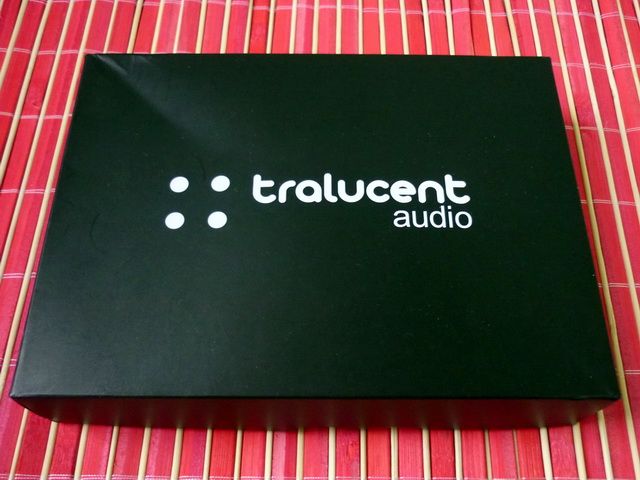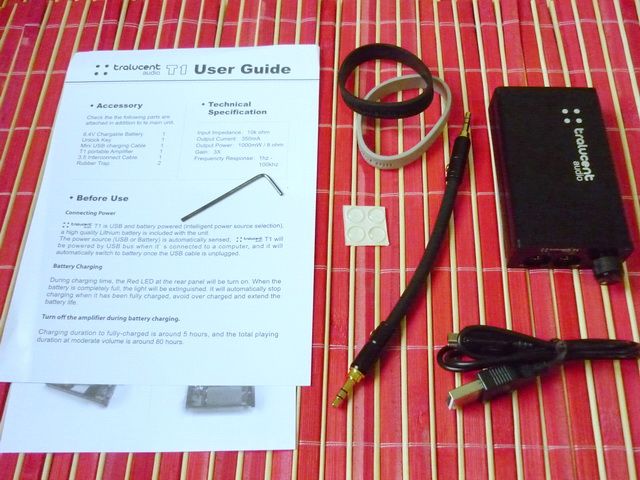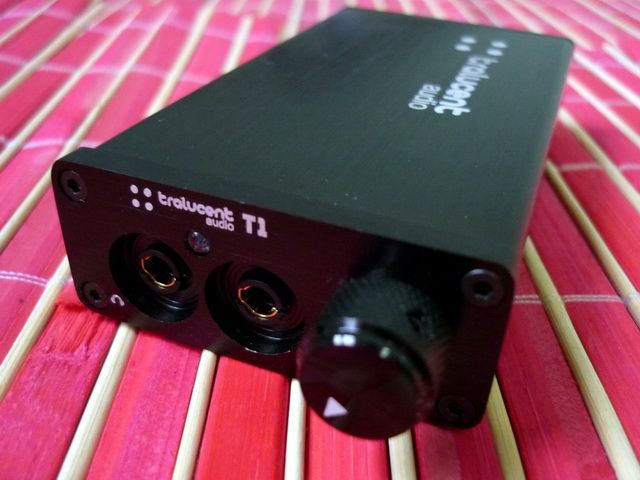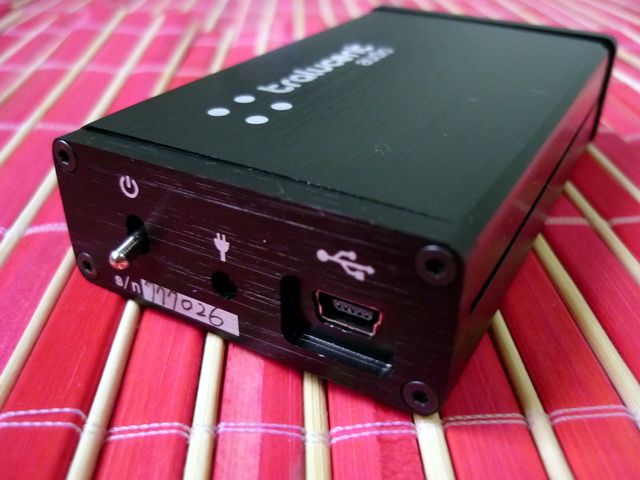
Spec
Input Impedance: 10k ohm
Output Current: 350mA
Output Power: 1000mW / 8ohm
Gain: 3x
Frequency Response 1Hz – 100kHz


The plug on the IC looks great, reminds me of the very expensive ViaBlue T6s 3.5mm mini.
Build Quality and Accessories
Build quality is good but the overall design isn’t out of the ordinary. The headphone jack are recessed so big 3.5mm plug might not fit the jack, plus the two jack are a little too close in my option. Just a little bit further apart would have been better. The size of the amp isn’t exactly small, but not particular big either. I’ll call it regular in size. Power switch and USB recharging port is on the rear with a red LED recharging indicator. The amp can run on either battery or USB power. It will run on USB power automatically when it is plugged in and it has smart circuit to prevent over-charging. There is also a blue LED power indicator on the front. All and all, it is a no thrill design.
Accessories wise, there are two rubber bands to strap the amp to the source, 4 stick-in rubber feet, a USB cable for recharging, a really good quality 3.5mm-to-3.5mm inter-connecting cable and a small Allen key for opening up the amp during battery replacement. The included 9V like battery seems to be NiMH based, which should last you a year or two on regular use. Unfortunately the battery is glued onto the housing with some very strong double sided tape, which makes it hard to remove and therefore preventing me from having a looking at what opamp and topology the T1 are using. It also means it won’t be the easiest thing to do when it is time for battery replacement. But hopefully by that time, the double sided tape would have loss some of its strength over time.


Battery Life
Battery life is quoted at 80 hours with a full charge with moderate volume and it takes 5 hours for a full charge. I never run the amp long enough to drain the battery completely but it does seems that it can run for a very long time. The one thing I noticed is that the amp does drain the battery a tiny bit even when turned off (likely because of the smart charging circuit), so the battery will empty if you leave it on the shelf for too long. The good news is that NiMH battery usually behaves fairly well when over-drained as they don’t suffered from memory effect much, but it is still a good idea to recharge the T1 every 2 weeks or so even if you are not using it.
Hissing + EMI + Click and Pop
Hissing is almost inaudible most of the time except for a second when the amp is shutting down where the hissing increases to a very mild level. EMI is noticeable on a very low level when the amp is next to a cellphone receiving call, not enough to be annoying. Click and pop on power up is also fairly low, safe enough to leave the IEM plugged in when turning the amp on. Overall, T1 behaves quite well.
SQ
My amp review usually consists of two parts: First is the basic measurement over RMAA for checking FR curve and noise over a known reference, measurement on power and power drop on fixed loads and a check on the output impedance. A second part is a subjective comparison. Like the amp shoot out, O2 will be the reference amp here. The source is either ODAC or Fuze’s line-out, the audio interface used is Behringer UC222 – not the best, but good enough for basic measurement. The USB port has been isolated with a USB isolator so ground loop shouldn’t be a problem.
As far as RMAA goes, T1 pretty much passes with flying color. The FR curve is dead flat from 20Hz to 20kHz. Noise is almost as low as O2 (or at least the limitation on what I can measure with my setup), and isn’t an issue of course. The only area that T1 doesn’t measure as well is stereo crosstalk. With O2 at -61.6dB on 16ohm load, T1 only measures -52.5dB. Still, it is a good enough number. Output impedance is measured and calculated at around 0.55ohm using a 47ohm load and a 1kHz tone. Power over the same load is slightly higher than O2 and almost matching that of Leckerton Audio UHA-4, which means it should have plenty of juice to spare. For the 20 or so portable amps I measured in the past, the best of them has very little to no power drop when I tested them from a 47ohm to a 23.5ohm load. T1 on the other hand not only has no power drop, it actually outputs 3% more power with the lower impedance load. That’s really something I never see on another amps and an indicator that T1 might works very well with low impedance IEM, especially since its has a low output impedance already.
For subjective listening, I mainly compare T1 to O2 and UHA-4, volume matched with a digital SPL meter. For most parts, T1 is almost as reference sounding as O2, very neutral and almost colorless. Yes, almost – not completely colorless but still less colored than UHA-4. There is a much fainted sense of warm lingered in the background that makes T1 not sounding as dark and transparent as O2 – thought the difference is very small and can be unnoticeable if you are not looking for it. With O2, it is like watching the night sky with a normal telescope where there is nothing between the stars and you are staring into the great emptiness. With T1 however, it is like watching the same night sky with a high power telescope where you start to notice there are something in between the stars but still can’t quite make out what they are, except you know there are something there. It is that kind of very weak radiance that gives the T1 that slight warmness over O2. For most part, I don’t dislike it and find it to be excellent match to colder and more neutral IEM like ER4S in a subtle way. All and all, I’ll rate T1 as good sounding as O2 as far as my own listening goes.

Size comparison (from left): iBasso D-ZERO, JDS Labs C421, Tralucent T1, Leckerton Audio UHA-4
Ending
There is really nothing I can complain about T1. It measured quite good, it sounds excellent and it behaves well with cellphone and low impedance load in real world application. It is pretty much what I’ll refer as a reference class, top-tier portable amp - at least from the viewpoint of an IEM user. The $230 price tag seems a bit high as you can get pretty decent amp/DAC for around the same price bucket. But if price is not an issue and you don’t need other functions, the T1 is a great alternative to O2, especially if you need something smaller for a true portable rig.
A thank to Tralucent Audio for the T1 loaner.





